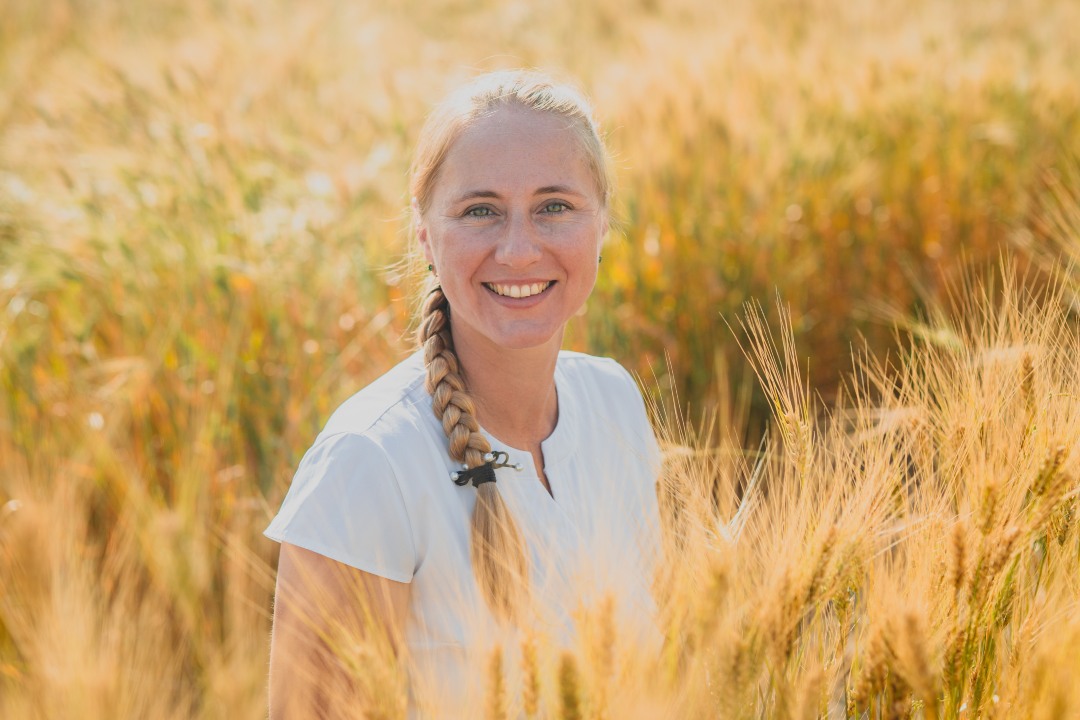
Better crop resilience through genetic diversity
Wheat – a vital food crop that feeds billions of people worldwide – plays an important role in food security. Estimates place global wheat production at nearly 800 million tonnes this year, volumes that can be achieved, in large part, due to targeted breeding of high-yielding cultivars.
By Globe and Mail Next-Generation Farming and Food Security ReportCommon wheat, which accounts for 95 per cent of this production, has evolved from wild grasses through domestication. This progression, however, has come at a price, namely a loss of genetic diversity, says Valentyna Klymiuk, a researcher in the College of Agriculture and Bioresources at the University of Saskatchewan (USask).
"Wheat species are diverse in so many aspects, representing adaptation to a wide variety of natural conditions. This genetic diversity has implications for food security as it can create climate resilience," says Dr. Klymiuk whose work focuses on crossbreeding wild and domesticated wheat to accelerate variety development for Saskatchewan producers.
"I'm trying to bring in some of the lost genetic diversity and incorporate beneficial traits from wild relatives – such as disease resistance and tolerance to abiotic stresses – while limiting incorporation of undesirable traits," says Dr. Klymiuk, who was recently appointed Saskatchewan Wheat Development Commission Applied Genomics and Pre-breeding Chair, a position that is supported by the Saskatchewan Wheat Development Commission (Sask Wheat), a farmer-funded organization representing the province's wheat producers.
"It is very exciting that this work began with recognition and funding from farmers, who believe this is important," she says. "We work very closely with farmers to understand what they are looking for in cultivars, and this guides the direction of our research and breeding efforts."
New cultivars able to adapt to changing conditions
Wheat breeding is a long process of crossing parent plants with desirable traits, then selecting and testing the offspring over many generations. Working with wild relatives means "an even longer breeding cycle due to a lot of crossing and back-crossing to achieve the quality and yield profile [of domesticated wheat]," says Dr. Klymiuk, who explains that every parent has advantages and disadvantages.
One potential disadvantage relates to seed dispersal, with wild wheat allowing its seeds to shatter, while the tougher central stalk in domesticated wheat holds the seed together for easier harvesting. Lodging – which refers to the bending over or falling of plants – is also a major cause of yield loss.
However, "one cultivar, for example, could be lower yielding but have great fusarium head blight resistance," says Dr. Klymiuk, who explains that since fusarium head blight is a significant fungal disease affecting wheat, breeders have to achieve a balance between improving resistance and maintaining quality and yield. "We want to bring in fusarium resistance without destroying our grade profile. So, in a field where we have thousands of plants growing, we would remove everything that is susceptible to fusarium and then select for the best yielding plants."
To achieve consistently expressed traits, material undergoes multi-year trialing, she notes. "One year could have perfect conditions for yields while another could have drought or disease.
This gives us insights into how well our new candidates for cultivars are performing across different environments and under different conditions."
Making such lengthy efforts worthwhile are the "valuable traits genetic diversity represents, particularly adaptability," adds Dr. Klymiuk, where breeding strategies look to advance climate resilience for current as well as potential future conditions.
A 'package of solutions' for the agricultural sector
With a focus on improving crop varieties, supporting farmer profitability – and ensuring the long-term sustainability and competitiveness of the agricultural sector, the Crop Development Centre (CDC) at the University of Saskatchewan is one of Canada's leading public breeding organizations.
"Canada provides the best quality wheat around the globe," says Dr. Klymiuk. "So, a focus on quality is very important for us, since the reputation for having really great products is what keeps us in many markets."
Plant breeding has been crucial for Canadian wheat production, and public breeding programs have been especially impactful. According to a recent study, for every dollar invested by the CDC, growers receive a $12 benefit-cost return.

This impressive track record has been achieved, in part, through a commitment to building excellence in USask's "six signature areas of research," says Dr. Baljit Singh, the university's vice-president, research. "It started with first identifying our strengths, which include agriculture, energy and mineral resources, Indigenous Peoples, synchrotron sciences, one health, and water security. Beyond that, what is required is to support collaboration and consistently expand our capacity for research and innovation." USask now has nine recognized signature areas of research.
“Usask has an impressive track record in research and innovation across many areas including agriculture, infectious diseases and vaccine development, water security, and work with indigenous peoples,” says Dr. Singh. “The agriculture research and innovation system at USask has developed over more than a century.”
With deep roots in agriculture, USask has long-standing connections to local food producers – and also hosts the Global Institute for Food Security, a globally renowned centre of excellence in agriculture and food-system related research.
Such endeavours are multidisciplinary by nature, says Dr. Singh, who points out the influence of agriculture, economics, sociology, technology and more on food systems.
"Just look at the confluence of agriculture and digital technologies, where developments in computer science, machine learning, AI and quantum computing are changing how we grow food," he explains. "When we bring together advances in diverse fields, we can come up with a package of solutions for the agriculture sector and advance global food security. "
With the goal to accelerate farming into the digital age through research, teaching and innovation, the Nutrien Centre for Digital and Sustainable Agriculture is another facility at USask dedicated to creating more sustainable and resilient food systems.
One of the centre's platforms is a digital twin that integrates soil mapping, digital agronomy, yield analysis, ecosystem modeling and climate data with the goal to enhance decision-making, at both farm and policy levels.
Precision agriculture also helps advance data-driven practices, and Dr. Klymiuk says it provides farmers with valuable information "about conditions in their field that enable crop selection as well as when to seed and fertilize – and harvest."
Success, in agriculture, "depends on so much more than just having the best cultivar," she says. "Farmers appreciate having access to research that supports them with knowledge and technology development. But we also learn from farmers who do their research on the farm to try new things."
Dr. Singh sees the particularly strong feedback loop with farmers as a significant advantage. "When we provide a solution to farmers, we hear back very soon, perhaps at the end of the first crop cycle, about how it went," he notes. "And that is very useful, because we look at innovation from a perspective of how people in our communities can use it, for example, to improve outcomes in farming and food security."
Efforts like Dr. Klymiuk's illustrate USask's commitment to using its expertise and resources to improve outcomes in communities and across society, according to Dr. Singh.
"At the end of the day, our focus is on making a contribution to solving some of the tough challenges the world faces today," he says. "Food security is one area where we've seen success in our efforts to support the health, sustainability and prosperity of the local and broader communities."

